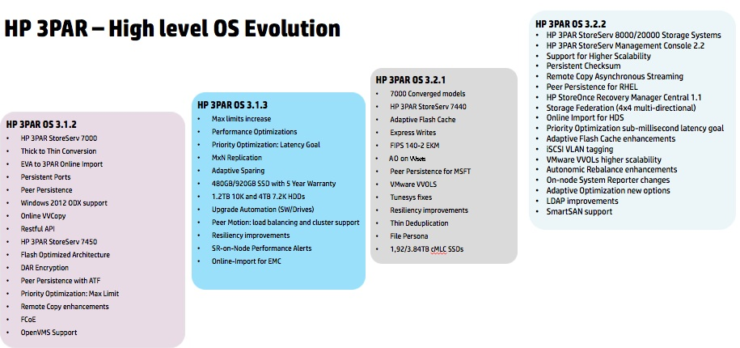At the end of last week 3PAR OS 3.2.2 was released. It contained a significant number of enhancements and new features, here are the highlights:
- Support for the new 8000 and 20,000 models
- The Persistent Check Sum feature announced at HP Discover becomes available
- Remote copy is enhanced with the availability of the asynchronous streaming mode also announced at HP Discover
- File persona enhancements – Useable space doubled to 128TB, thin dedupe available and AV protection added
- Peer motion now allows Storage Federation
- HDS added to list of systems Online Import can be used with
- Raid 0 AFC layout as default
- Greater scalability, including support for multiple VVOL containers
- Greater control over AO. For each CPG you can define a minimum and maximum space utilisation. Definitely interested to try out this new feature
You can see a summary of the new features in the last few major 3PAR releases below. This graphic was originally featured in the official HP storage blog and you can read the full post here
You can read about the full set of features in the 3PAR OS 3.2.2 release notes.
To stay in touch with more 3PAR news and tips connect with me on LinkedIn and Twitter.


When will new 3.2.2 MU3?
Hi you will need to ask your HPE rep for that info
Thanks!
3.3.3 MU3 released Yesterday and we applied successfully on one of the 20450 array
Do you mean 3.3.3, I am not aware of a version after 3.2.2 at the moment
It’s really 3.2.2 MU2 🙂
It is now, yes as this was written some time ago.
Can someone explain HP’s practice of their “Recommended” OS? As I understand, their current recommendation is 3.2.1 MU5. Yet, I require 3.2.2 for compatibility with Windows Server 2016. Am I taking risk by moving to 3.2.2 as it is not “recommended”?
HPE normally do a phased release of any new updates. Although 3.2.2 has been out for some time so not sure why it would not be recommended to you.
Just got the reply from HP: As per HPE StoreServ Engineering the recommended HPE 3PAR OS version for P7000 &P10000 arrays is 3.2.1.MU5 and HPE 3PAR OS 3.2.2.EMU2 is the default code for 8000 & 20000 model arrays.
So I want to move to Server 2016… but… do I go against their “recommended” OS? Of course, they won’t tell me why.
SPOCK has been updated as of January 20th, 3.2.1 MU5 is now compatible with Windows Server 2016.
So, is VVOL and AO works together?
I couldn’t find any documentation about it.
I placed some VVOLs on a CPG which is part of AO policy (via VMware Storage Policy), will it really perform the storage tiering?
Is there any way to verify/test it?
How can I see which blocks from a VM data are on which CPG/disk?
HPe is missing documentation about it and its really not clear.
VVOLs and AO are not supported together. The supported features are listed here on page 6 https://www.hpe.com/h20195/v2/getpdf.aspx/4AA5-6907ENW.pdf